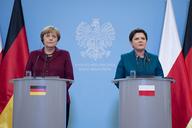Subject

photo credits: Wikimedia Commons
The bilateral relations between Poland and Germany have been marked by an extensive and complicated history. From the 10th century onward, the Piast-ruled Kingdom of Poland established under Duke Mieszko I had close and chequered relations with the Holy Roman Empire. However, these relations were overshadowed in the Late Middle Ages both by the push eastwards of the Margraviate of Brandenburg into Polish territory and the centuries-long Polish–Teutonic Wars, as a result of which the State of the Teutonic Order became a part and fief of the Kingdom of Poland, later transformed with the consent of the Polish King into the secular Duchy of Prussia. Prussia retained a certain level of autonomy under Polish rule. Later, the Kingdom of Prussia rose and eventually became one of the three partitioners of Poland in 1772–1795. Following the partitions various anti-Polish policies were pursued, including the Kulturkampf, Germanization and expulsions of Poles. That period was also marked by several Polish uprisings against Prussian rule, including the Greater Poland uprising of 1848 during the European Revolutions of 1848. Particularly, the November Uprising of 1831 triggered enthusiasm for the Polish cause among German liberals, mocked by conservatives as Polish gushing (Polenschwärmerei). These German liberals however felt that their political ideals for Germany corresponded to the Polish hopes. Throughout the German lands a network of organizations devoted to supporting the Poles appeared. After World War I, in 1918, Poland regained independence and its place on the map. Under the Treaty of Versailles, Poland regained most of the territories lost to Prussia in the Partitions of Poland and parts of territories lost even earlier, while Gdańsk (Danzig) became a free city in customs union with Poland. It was seen as a great injustice in the Weimar Republic, in part leading to the Nazi takeover of power in 1933. On 1 September 1939, Poland was invaded by Germany, thus initiating World War II. The Third Reich established concentration camps in German-occupied Poland, the biggest located in Auschwitz. During the war, Poland suffered circa 6 million casualties and it also suffered huge material losses because Germany sought to commit genocide against its Polish, Jewish and Roma populations. As a result of World War II and the decision of the Big Three, Poland lost the eastern half of its territory, which was annexed by the Soviet Union, and as compensation for this loss, it received most of the pre-war eastern territories of Germany, which it had previously lost, either in the Partitions of Poland or earlier. From 1945–1950, a series of flights and expulsions occurred, in which up to 11 million ethnic Germans were forced to leave their homes in Poland and resettle in post-war West and East Germany. It was the largest forced displacement of a population in history. The Cold War saw good relations between the communist states of People's Republic of Poland and the German Democratic Republic. Polish-West German relations, on the other hand, were strained, although they improved after Chancellor Willy Brandt launched the Ostpolitik. In 1990, Germany reunified and it confirmed the Polish-German border on the Oder-Neisse line in a treaty. Both states are now NATO and the European Union allies and partners, having an open border and being members of the European Single Market. Both countries are also members of the OECD, OSCE, the Council of Europe, the Council of the Baltic Sea States, HELCOM and the World Trade Organization. The once poor relationship between Poland and Germany has now become a strategic partnership. Source: Wikipedia (en)
Works about Germany–Poland relations 1
Subject - wd:Q3424088
